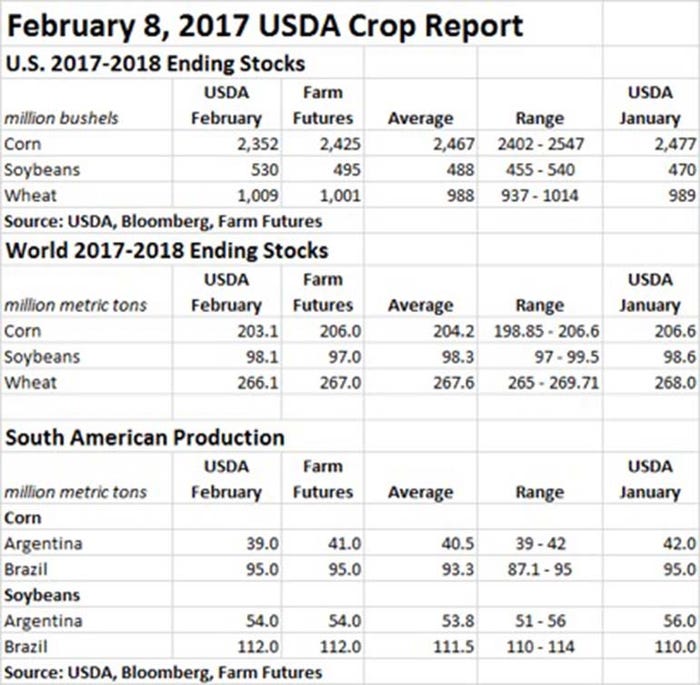
Futures were little changed Thursday, following release of a USDA report that had something for both bulls and bears.
The latest USDA World Agricultural Supply and Demand Estimates (WASDE) pushed corn prices slightly higher and wheat prices slightly lower, on a mixed bag of data. The report has projected U.S. and global wheat stocks trending slightly higher. It also reinforced concerns about Argentina’s soybean production, kicking prices higher following its release.
Analysts had projected U.S. ending stocks would average 2.467 billion bushels. USDA’s February tally came in below that, at 2.352 billion bushels after trimming 125 million bushels from its January estimates, citing improved price competitiveness and lower exports from Argentina and Ukraine.
USDA’s projection for world ending corn stocks was also below trade estimates of 204.2 million metric tons, at 203.1 MMT. That’s moderately lower than the agency’s January estimates of 206.6 MMT, a drop of approximately 137.8 million bushels. Again, lower production estimates from Argentina and Ukraine account for the majority of this change.
USDA’s estimates for 2017/18 South American production had Brazil unchanged, at 3.740 billion bushels. Analysts had expected the agency to trend slightly lower, with an average trade guess of 3.673 billion bushels. USDA did lower its estimate for drought-stressed Argentina corn from 1.653 billion bushels in January to 1.535 billion bushels.
USDA’s estimates for U.S. soybean stocks increased, meantime, from 470 million bushels to 530 million bushels. Trade estimates also anticipated a rise in 2017/18 ending stocks, but the average guess of 488 million bushels was moderately lower than USDA’s official February tally.
World soybean stocks, on the other hand, fell slightly, from 98.6 million metric tons to 98.1 MMT, a difference of approximately 18.4 million bushels. That was a slightly more bullish drop than the average trade guess of 98.3 MMT.
USDA increased its Brazil soybean production estimates, but lowered its Argentina production estimates. Brazil’s 2017/18 soybean production potential is now 4.115 billion bushels, compared to 4.042 billion bushels in January, according to the agency. In Argentina, that production potential fell from 2.058 billion bushels in January to 1.984 billion bushels.
U.S. wheat ending stocks trended slightly higher, from 989 million bushels to 1.009 billion bushels – ahead of the average trade guess of 1.001 billion bushels. World stocks moved lower, however, from 268 million metric tons to 266.1 MMT, a difference of about 69.8 million bushels. Increased exports from Russia, Argentina and Canada more than offset reductions from the U.S. and European Union.
Indonesia imports increased enough to unseat the world’s traditional No. 1 importer, Egypt.
USDA made no changes to its season-average farm price for wheat, still at $4.60, although the agency narrowed its projected range by 5 cents on either ends, to $4.55 and $4.65.
“Corn received the most positive news out of today’s report,” says Farm Futures senior grain market analyst Bryce Knorr. “In addition to the boost to exports, the agency’s reduction of Argentine corn production suggests the impact of the drought there isn’t done yet. That could help soybeans down the road which is why the bean market is trying to hold up despite bearish numbers from USDA.”
Soybean exports may not be as bad as USDA fears, but unless China comes back to the table, they may well be, Knorr adds. It’s also important to note China’s Lunar New Year holidays close markets there from February 16-22, a tradition that could create a news vacuum just as trade tensions heat up with the U.S., he says.
Although wheat sales are sluggish, they shouldn’t get a whole lot worse, Knorr says.
“The impact from this report should be quickly put in the review mirror as the market focuses on farmers’ planting intentions and dry conditions in the U.S.,” he says. “Wheat is also getting hit today from technical selling after the market became overbought, with weakness exacerbated by gains in the dollar. That’s a reminder that we can’t ignore the nose from outside markets, which appears to be intensifying again today.”

About the Author(s)
You May Also Like






